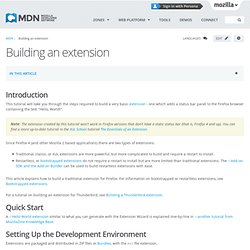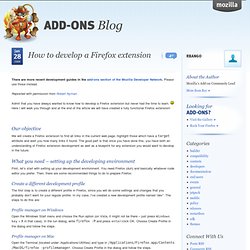

Web development » How to create Firefox extensions. (Note: This article is pretty dated by now.

It’s still a good way to get the foundations of making a Firefox extension, but use it as a guide instead of an absolute reference. If you’d like to see how to create a Google Chrome extension, you can read this article here: Everyone has a good idea at one time or another to implement a new feature in a web browser. Well, with the goodness that is Mozilla Firefox, now you can do just that. You need to have a vague understanding of XUL and Javascript, but you certainly don’t need to be a master of either. Contents Learn by example Everyone has a good idea at one time or another to implement a new feature in a web browser.
Basically, this tutorial will show you how to create your first extension from scratch. Xul Planet has a nice little tutorial which will show you the basics of creating a menu. Hello, world! Our extension will be a nice simple one that will pop up a window proclaiming “Hello, world!” Right-clicking will get us this: So choose 4. How To Write Your First Firefox Extension. How to develop a Firefox extension. There are more recent development guides in the add-ons section of the Mozilla Developer Network.

Please use those instead. Reposted with permission from Robert Nyman: Admit that you have always wanted to know how to develop a Firefox extension but never had the time to learn. Here I will walk you through and at the end of the article we will have created a fully functional Firefox extension! Our objective We will create a Firefox extension to find all links in the current web page, highlight those which have a target attribute and alert you how many links it found.
Builder and SDK. Building an extension. Introduction This tutorial will take you through the steps required to build a very basic extension - one which adds a status bar panel to the Firefox browser containing the text "Hello, World!

". Note: The extension created by this tutorial won't work in Firefox versions that don't have a static status bar (that is, Firefox 4 and up). You can find a more up-to-date tutorial in the XUL School tutorial The Essentials of an Extension. Since Firefox 4 (and other Mozilla 2 based applications) there are two types of extensions: Traditional, classic, or XUL extensions are more powerful, but more complicated to build and require a restart to install. This article explains how to build a traditional extension for Firefox. For a tutorial on building an extension for Thunderbird, see Building a Thunderbird extension. Quick Start A Hello World extension similar to what you can generate with the Extension Wizard is explained line-by-line in another tutorial from MozillaZine Knowledge Base.
<? XUL Overlays. How to develop a Firefox extension. There are more recent development guides in the add-ons section of the Mozilla Developer Network.

Please use those instead. Reposted with permission from Robert Nyman: Admit that you have always wanted to know how to develop a Firefox extension but never had the time to learn. Here I will walk you through and at the end of the article we will have created a fully functional Firefox extension! Our objective We will create a Firefox extension to find all links in the current web page, highlight those which have a target attribute and alert you how many links it found.
What you need – setting up the developing environment First, let’s start with setting up your development environment. Create a different development profile The first step is to create a different profile in Firefox, since you will do some settings and changes that you probably don’t want for your regular profile. Profile manager on Windows Profile manager on Mac Profile manager on Linux Configuration settings for Firefox install.rdf.
User Script Compiler.